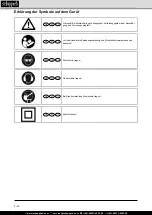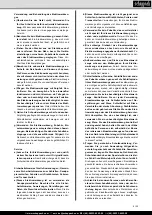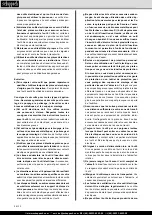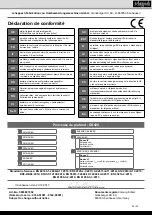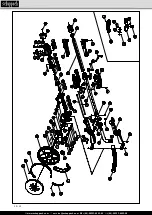
www.scheppach.com
+(49)-08223-4002-99
+(49)-08223-4002-58
16 І 32
sure that the power tool is switched off before you
connect it to themains and/or insert a battery, pick
it up or carry it.
lf you have your finger on the switch
when you carry the power tool, or if the machine is
switched on when you connect it to the mains, this
may result in accidents.
d) Remove adjustment tools or wrenches before
switching on the power tool.
Tools or wrenches in
rotating machine parts may cause injury.
e) Avoid abnormal body positions
. Stand securely and
keep your balance at all times. By doing so, you can
control the power tool more easily in unexpected Situ-
ations.
f) Wear suitable clothing. Do not wear loose cloth-
ing or jewellery.
Keep your hair, clothing and gloves
away from moving parts. Loose clothing, jewellery or
long hair may be trapped in moving parts.
g) lf dust extraction tools or collection bins can op-
tionally be attached, you must make sure that they
are connected and correctly used.
Using dust ex-
traction tools may reduce risks caused by dust.
Use and treatment of the power tool
a)Do not overload the tool. Use the appropriate pow-
er tool for your type of work.
With appropriate power
tools, you can work better and more safely within the
given power range.
b) Do not use power tools with defective switches.
Power tools which cannot be switched on or off are
dangerous and must be repaired.
c) PuII out the plug from the socket and/or remove
the battery before you make settings to the tool,
replace accessory parts or put aside the power
tool.
These precautionary measures will prevent the
power tool from starting unintentionally.
d) Keep power tools which are not in use away from
children. Only persons who are familiar with the
power tool and who have read the operating in-
structions may use the power tool.
Power tools are
dangerous if used by inexperienced persons.
e) Maintain power tools with care. Check moving
parts for proper function and smooth running, and
check whether there are parts which are broken
or damaged to the extent that the functionality of
the power tool is impaired.
Have damaged parts
repaired before using the power tool. Many accidents
are caused by poorly-maintained power tools.
f) Keep cutting tools sharp and clean.
Carefully main-
tained cutting tools with sharp edges are less likely to
jam and can be guided more easily.
g) Use power tools, accessory parts, insertion tools,
etc. in compliance with these instructions.
Take
into account the working conditions and the activity
which is to be carried out. Using power tools for ap-
plications other than those intended may cause dan-
gerous Situations.
Service
a) Have your power tool repaired by qualified special
-
ists only, and always use original spare parts for
repair.
This is to maintain the safety of the power tool.
General safety notes for power tools
Warning! Read all safety notes and instructions! Non-
compliance with safety notes and instructions may result
in electric shock, fire and/or severe injury!
Store all safety notes and instructions for the future.
The term „power tool“ used in the safety notes refers to
power tools connected to the mains (with a power ca-
ble) or operated with a battery (without a power cable).
Workplace safety
a) Keep your workplace clean and wellilluminated.
Disorderliness and poorlyilluminated workplaces may
Iead to accidents.
b) Do not operate the power tool in explosive atmos-
pheres with inflammable liquids, gases or dust.
Power tools generate sparks which may ignite dust
or vapours.
c) Keep children and other persons away from the
power tool during operation.
You may lose control
of the tool if you are distracted.
Electric safety
a) The plug of the power tool must fit into the socket.
Do not modify the plug in any way. Do not use adapter
plugs tagether with grounded power tools. Unmodified
plugs and matehing sockets reduce the risk of electric
shock.
b) Avoid body contact with grounded surfaces such
as pipes, radiators, ovens and refrigerators.
There
is an increased risk of electric shock if your body is
grounded.
c) Keep power tools away from rain or humidity.
Wa-
ter permeation into the power tool will increase the risk
of electric shock.
d) Use the cable solely for its intended purpose. Do
not use the cable to carry or hang up the power
tool or to pull out the plug from the socket.
Keep
the cable away from heat, oil, sharp edges or moving
machine parts. Damaged or twisted cables increase
the risk of electric shock.
e) When working outdoors with power tools, only use
extension cords which are suited for outdoor ar-
eas.
Using extension cords suited for outdoor applica-
tions reduces the risk of electric shock.
f) lf the operation of power tools in a humid environ-
ment cannot be avoided, you must use a residual
current circuit breaker.
The use of a residual current
circuit breaker will reduce the risk of electric shock.
Personal safety
a) Pay attention to what you are doing and use power
tools sensibly. Do not use power tools when you
are tired or under the influence of drugs, alcohol
or medication.
A single moment of inattention while
using power tools may cause severe injury.
b) Wear personal protective equipment and safety
goggles.
Wearing personal protective equipment such
as a dust mask, non-skid safety boots, a protective
helmet or hearing protection according to the type and
application of the power tool reduces the risk of injury.
c) Avoid starting the power tool unintentionally. Make





